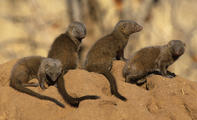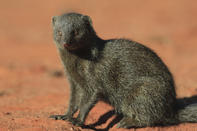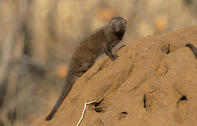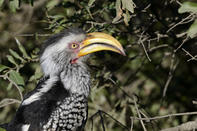Small and Varied
Dwarf mongoose are accomplished hunters and use many different techniques to capture their prey which comprises mostly of insects but includes formidable creatures like scorpions, centipedes and snakes and even some small mammals.

Most typically, dwarf mongoose use their sharp claws to dig up prey that they detect underground. Sometimes while digging intently their heads may even disappear completely into the excavation. This necessitates the good guarding system.
They are astute pouncers and either jump to snatch airborne insects or bound upon terrestrial ones consuming those head first. Mice are dispatched in a similar manner being pinned with the forefeet and bitten upon the head. Larger prey like lizards are killed with multiple bites and a canid-like death shake.
Snakes are bitten behind the head, shaken and then dropped repeatedly. Larger snakes may be tackled cooperatively with some members shaking the snake by its tail while it is gripped behind the neck by another mongoose. In order to avoid the stings of certain insects, these will be chewed with the lips held away from the teeth.
The stings of scorpions don’t seem to pose a problem and are even consumed on smaller specimens.
Sun Up to Sun Down

Dwarf mongoose are strictly diurnal only leaving their nighttime refuges well after the sun is up and entering the new one before the sun goes down. Being small animals, they are susceptible to getting cold at night and they ritually sun themselves first thing in the morning.
The alpha female is always first to emerge and she will check that the coast is clear before summoning the rest of the group to emerge.
The pack will engage in social activities during this time. They groom themselves and each other assiduously transferring saliva and scent amongst themselves so the whole group shares a unique smell. This identifies them to each other and separates them from other packs.
Guards

Dwarf mongoose spread out when they feed but maintain contact among themselves with constant ‘peeping’ noises. Sentinels are posted on vantage points both ahead of and behind the foraging group and they too emit ‘all clear’ sounds every few seconds so that the feeding individuals need not waste time looking up from their excavations.
The guards will rise up on their hind legs using their tail as a tripod balance in order to gain the best view of the surroundings. Sentinel duty lasts only about 15 minutes each and as soon a relief guard is set up, usually once the group has foraged about 60 metres from the rearguard, then the individual that has been on duty will resume feeding.
It must scamper the 60-metre distance to catch up with the group and is exceptionally vulnerable to predators during this dash. If the group becomes very spread out or particularly preoccupied in a good feeding area, additional guards will be set up. Guard duty is shared among the pack but the subordinate adult males engage in it most often and some individuals more than others.
Mutual Symbiosis

Yellow-billed and red-billed hornbills regularly forage with dwarf mongoose to benefit from insects flushed up but missed by the mongoose. The hornbills return the favour by alerting the mongoose of danger.
They even sound the alarm for raptors that are not a threat to themselves but are a danger to the mongoose. This valuable warning service relieves the pressure on the mongoose pack to be especially vigilant and fewer individuals need to take time out of feeding to act as sentinels when the hornbills are around.
So mutually beneficial is this relationship that the hornbills will wait at the mongoose’s nighttime refuge for them to emerge in the morning, often becoming impatient and calling down the holes to rouse them, and the mongoose may delay their departure from a sleeping site if the expected hornbills are late.
By Megan Emmett